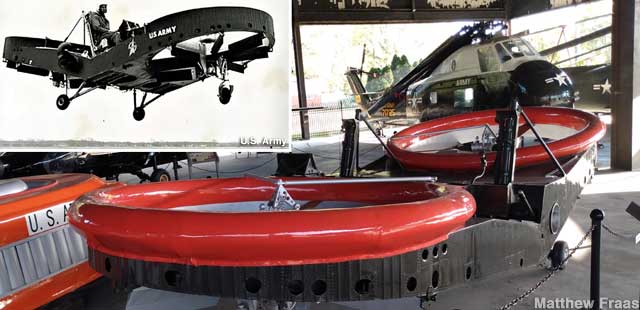
Army planners hoped the VZ-8 Airgeep could transport and drop small nuclear bombs.
U.S. Army Transportation Museum
Fort Eustis, Virginia
For those fascinated by military logistics, the U.S. Army Transportation Museum is a satisfying destination, with exhibits about the role of the Conestoga wagon in the Revolutionary War; the famous "Red Ball Express" truck convoys of World War II; and the rapid loading and unloading of entire trains, a trick taught to the Army by the Ringling Bros Circus.
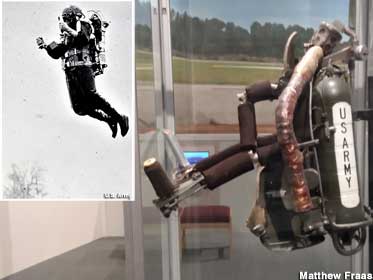
The highly-combustible Bell Rocket Belt: unfit for any battlefield.
For the rest of us? This museum might sound like a place too specialized for offbeat enjoyment -- but that would be a false impression, because nested among its Jeeps, Humvees, and Huey helicopters are some of the weirdest sci-fi-inspired vehicles anywhere on the planet.
"The Army spent a lot of time and money trying to come up with the next new vehicle that would give us a big advantage," said Matthew Fraas, the museum's education specialist. "'Let's try this! Oh, that didn't work. Let's try that!' Most people don't know about them until they get here."
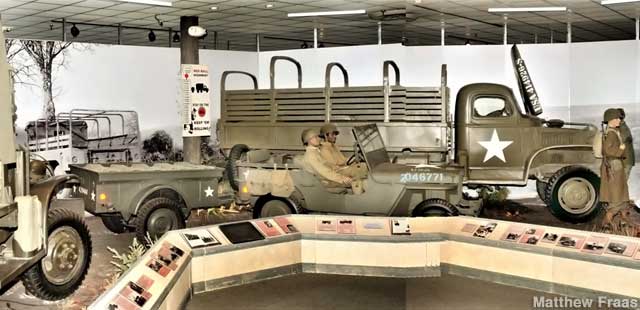
Working nonstop, Red Ball Express convoys hauled supplies to the front lines from the Normandy beaches.
For example, there's the GEM Model 2500, a floating car from the 1950s that foreshadowed the Landspeeder from Star Wars. Held aloft on a cushion of air, the Model 2500 could zip over land and water at 40 mph. It was designed to resemble a late 1950s automobile because the manufacturer wanted to boost its appeal to potential car-of-the-future buyers. "It worked great as long as the ground was smooth and perfectly flat," said Matthew, but such a limited range was useless for the Army -- and for most civilians as well. The car was also deafeningly loud.
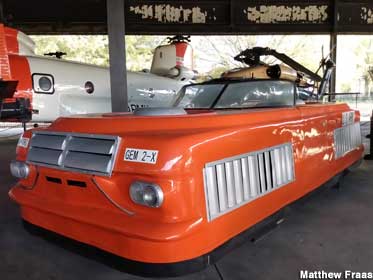
GEM Model 2500, a floating and very noisy car.
The bright scarlet paint on the museum's Model 2500 wasn't a styling choice; it was the regulation color for most Army experimental vehicles, so that everyone would know to get out of their way.
The HZ-1 Aerocycle, another Eisenhower-era brainstorm, prompts a universal reaction among visitors, according to Matthew: I would never go anywhere near that thing. Intended for reconnaissance and fast personal transport, it was actually tested at Fort Eustis, and its pilot, Selmer Sundby, once visited it in the museum. That he survived to do so is a testament to his piloting ability. The Aerocycle -- a tiny human platform suspended over two large spinning propellors -- would kick up rocks and other deadly shrapnel whenever it neared the ground, and its notorious instability meant that Captain Sundby was always one slip away from being chopped to bits by the blades.
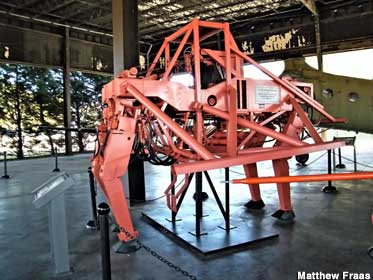
Cybernetic Walking Machine couldn't outrun its dependence on oil.
Less dangerous, but no more practical, was the 11-foot-high Cybernetic Walking Machine. It could, as advertised, cross -- very slowly -- rugged terrain impassible for any other vehicle, and its power-boosting hydraulics enabled a single human operator to lift herculean-heavy loads. But those hydraulics gulped up to 50 gallons of oil a minute, so the Walking Machine essentially had to be tethered to a tanker truck.
The museum displays a battered hull section of the VZ-9 AVROcar, the closest the Army ever came to having its own flying saucer. Twenty-six feet in diameter, the saucer, like the Model 2500, floated on a cushion of air, but failed at the "flying" part since it could never get more than three feet off the ground without wobbling into a potential crash. Two were built; one is at the National Museum of the United States Air Force, but the only one that ever flew is here, currently disassembled in a warehouse. The one-piece exhibit gives the Transportation Museum something to boast about. "The Air Force likes to rub it in: 'Ours is on display and yours isn't,'" said Matthew. "But we say, 'At least our piece flew; yours never did.'"
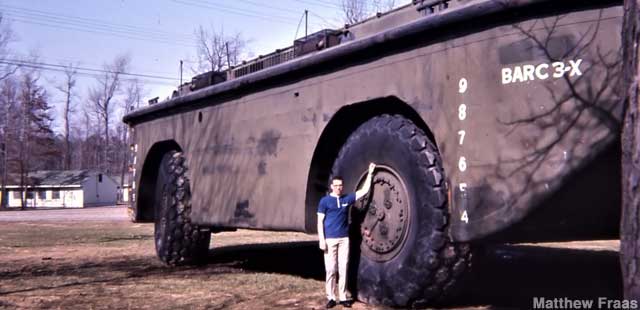
The BARC weighs 100 tons, with tires nine feet high.
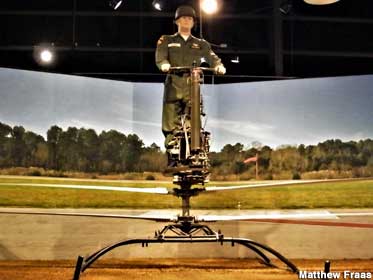
The HZ-1 Aerocycle: one uneasy pilot atop two giant propellors.
The lack of a complete AVROcar can be forgiven because the Museum offers so many other wonders, such as the Bell Rocket Belt -- the world's first jet pack -- which the Army tested for years, trying to figure out how to make it useful. That never happened, according to Matthew, because there was always the risk you'd run out of gas and crash, or land too fast and break your legs, or just be blown out of the sky by a bullet striking your fuel tank. Also on display is the VZ-8 Airgeep, a sort of helicopter-sedan which, according to Matthew, was evaluated as a possible human-powered delivery system for small nuclear bombs. "It only had a ceiling of 3,000 feet," said Matthew. "Once you drop the bomb, how far away are you going to get before the bomb goes off? It made no sense whatsoever."
(For more Cold War nuclear nonsense, read about the Atomic Mortar.)
Not all of the Army's extreme vehicles failed as prototypes. Some were driven and ridden by soldiers in wartime, and the museum has several in its collection. The 100-ton BARC, for example, was an armor-plated amphibious behemoth with tires nine feet high that could deliver a 60-ton Army tank or a fully equipped infantry company up a hostile beach and into the jungle if needed -- but it turned out to be unseaworthy. Also on display is the SK-5, the only surviving Army hovercraft from the Vietnam War -- which needed 20 hours of maintenance for every hour of operation. "There were three of them," said Matthew. "The other two were blown up by mines."
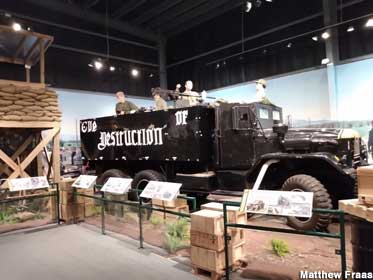
Eve of Destruction is the only surviving U.S. Army gun truck from the Vietnam War.
A rare example of a radical DIY Army vehicle is the "Eve of Destruction" gun truck -- another lone survivor from the Vietnam War. Gun trucks, according to Matthew, were improvised by Army drivers to protect their convoys, remodeling regulation cargo trucks into unsanctioned platforms of lethal firepower. "They had to scavenge their own armor and weapons," Matthew said. "As far as we know, this is the only one that made it back."
None of the experimental vehicles at the Transportation Museum are operational because the Army removes key parts before the vehicles are exhibited to the public. This is probably best from the standpoint of safety, but Matthew said that there's no shortage of Transportation Corps veterans who, given the chance, would happily volunteer to help make the museum's caravan of oddities crawl, roll, hover, float, and fly again.




